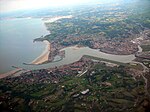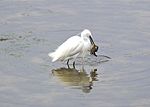Great Cross of Hendaye
Buildings and structures in Pyrénées-AtlantiquesIndividual crosses and crucifixesStone crosses

The Great Cross of Hendaye (French: Croix d'Hendaye) is a stone cross located on the town square of Hendaye, in the Pyrénées-Atlantiques, in southwestern France. The cross includes references to apocalyptic beliefs about Christianity, Rosicrucianism, and alchemy. Many, including devotees of Nostradamus, the Bible Code, and especially the 2012 phenomenon, believed that a great comet would pass by, or crash into the earth in the year 2012, and interpreted the Cross of Hendaye as another reminder that 2012 would be the end.
Excerpt from the Wikipedia article Great Cross of Hendaye (License: CC BY-SA 3.0, Authors, Images).Great Cross of Hendaye
Rue de l'Église, Bayonne
Geographical coordinates (GPS) Address Nearby Places Show on map
Geographical coordinates (GPS)
| Latitude | Longitude |
|---|---|
| N 43.358888888889 ° | E -1.7744444444444 ° |
Address
Église Saint-Vincent (Église Saint-Vincent-Diacre)
Rue de l'Église
64700 Bayonne, Centre-Ville
Nouvelle-Aquitaine, France
Open on Google Maps











